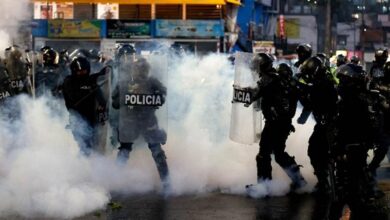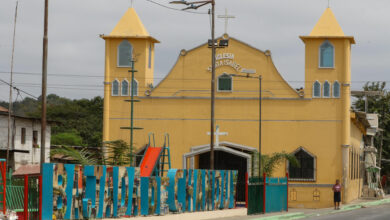Ecuador’s Energy Crisis: Turning to Colombia for Relief and Reform

Ecuador’s severe energy crisis, marked by power outages and economic losses, has prompted the country to seek assistance from Colombia. As Ecuador grapples with a mounting energy deficit, the prospect of regional cooperation emerges as a beacon of hope, offering both temporary relief and long-term solutions for a sustainable future.
A Dire Energy Shortage
Ecuador has been grappling with a severe energy crisis since mid-September 2023, plunging millions into darkness for up to 14 hours daily. These persistent power outages, far from being mere inconveniences, are now posing a serious threat to daily life, productivity, and the country’s overall economic stability.
In response to the worsening situation, Minister of Government Arturo Félix embarked on an essential trip to Colombia. His mission was to negotiate an energy deal that could help alleviate the country’s power shortages. The trip, prompted by President Daniel Noboa’s determination to prioritize the energy issue, represented an ongoing attempt to resolve Ecuador’s energy shortfall, which has crippled much of its economy.
However, there needs to be specifics about the kind of negotiations. I’m unsure if Félix’s Colombian discussions would involve reinvigorating a government-to-government energy deal or private Colombian energy companies. This confusion shows how perplexing the crisis is and how urgent it is for Ecuador to find short- and long-term energy solutions.
At the core of the crisis is Ecuador’s dependence on hydroelectricity. More than 70% of the country’s electricity used to be produced by hydroelectric stations, but the drought has crippled production. Therefore, Ecuador is left with a daily deficit of about 1,000 megawatts, which has forced the government to look elsewhere for energy – even to Colombia.
The Economic Fallout from Power Outages
This crisis isn’t just a brief inconvenience; it’s decimating the national economy. Consecutive blackouts of homes, businesses, and services have caused billions of dollars to be lost. According to the Quito Chamber of Commerce, $18 million is spent on the economy per hour of power outage. If the blackouts last five hours a day, the cumulative cost would be significant, with the total economic damage currently estimated between $3 billion and $3.5 billion. And the situation shows little sign of improving anytime soon.
Ecuador’s industrial sector, in particular, has been hit hard. Large factories, industrial units, and even hospitals have yet to be able to operate on the patchy power supply. The business has been calling for an urgent government response to shut down the power supply that’s crippled production and services. The outages have been, for most people, only adding to the existing financial woes, from inflation to collapsed supply chains and growing unemployment.
But the blackouts aren’t just confined to industry. In rural communities with greater frequency and duration of power outages, households and small businesses have had to do without electricity to heat, store food, and conduct their day-to-day operations. Public frustration is growing with no clear solution in sight and calls for government intervention are becoming louder.
The Strain of Hydroelectric Dependency
Ecuador’s energy situation stems mainly from its overdependence on hydroelectricity. Under ordinary conditions, the nation’s hydroelectric power plants can supply most of the national demand. Yet this year’s drought is so severe that Ecuador’s largest hydroelectric dams cannot get full power.
The country faces an energy gap of around 1,000 megawatts, a shortfall that the government needs help to bridge. Although the Toachi-Pilatón hydroelectric plant, with a capacity of 204 megawatts, is being fast-tracked to help ease the pressure, it won’t be enough to fully resolve the crisis. This shortcoming highlights the fragility of Ecuador’s energy model, which relies heavily on water-based power production.
According to an expert, the energy plan is no longer feasible due to climate change and increasingly unpredictable weather. The drought is affecting Ecuador and other South American countries that depend on water-based energy. Rainfall is increasingly erratic, and hydroelectric power is now well established as not a long-term solution.
There is growing support for diversifying Ecuador’s energy sources by investing in renewable energy such as solar, wind, and geothermal. These alternatives could provide a more reliable energy source, especially in regions where hydroelectric plants can no longer function efficiently. However, transitioning to these alternatives would require substantial upfront investment and a strategic long-term plan, which may take time to implement amid the current crisis.
Regional Cooperation and the Need for Reform
While Ecuador is turning to Colombia for support, the state also has structural problems in its energy industry. Ecuador’s energy system has languished for years because of low investments and no meaningful reforms. Government-owned companies have already supplied most of the country’s energy and have not caught up with demand or the environment.
The government’s failure to attract private investment in the energy sector has exacerbated the crisis. The energy market is nearly entirely closed to private companies despite Ecuador’s ample opportunities for growth in renewable energy. In a landscape with minimal competition, there needs to be more innovation or modernization, resulting in a grid that cannot meet the demands of a growing population and economy.
The recurrence of this energy scarcity has also led to a more extensive national discussion about reforms in the energy industry. It has taken decades for the government to open the market to private capital, but the current crisis might require political leaders to think twice. Some argue that letting private companies build energy generation, transmission, and infrastructure would promote innovation and efficiency and make our energy system more resilient. However, others worry that privatization will cost consumers more energy and less power to manage the nation’s assets.
Ecuador is currently at a critical juncture. The government must strike a delicate balance between the need for short-term relief—such as energy imports from Colombia—and the imperative for long-term energy reform. The challenges posed by this crisis could serve as a catalyst for vital reforms, but this will only materialize if political opposition is surmounted, and policies are put in place to attract more investment in the energy sector.
The Path Forward for Ecuador’s Energy Sector
Ecuador’s energy crisis has been on the rocks, and the government has to decide whether to continue borrowing resources from abroad to deal with the short-term crisis or make radical changes to address the situation at its source. Minister Arturo Félix’s visit to Colombia is a critical first step in obtaining temporary fixes, but it is not the silver bullet the country needs. Ecuador must do all it can to diversify and modernize its energy system to avert future emergencies.
Such a crisis, by its nature, also shows how crucial regional cooperation is. Since neighboring countries such as Colombia are also experiencing energy depletions, regional energy deficiencies could be tackled collectively. Ecuador and Colombia could not only coordinate to stabilize energy resources in the short term but also seek joint investments in renewable energy infrastructure. Partnerships could secure a healthier future for the two countries’ energy.
Ecuador’s path ahead is dual—short-term relief and long-term reform. It must also be a country of energy diversification and private energy investment. This would strengthen Ecuador’s energy system and make it more sustainable so it can better respond to future needs and challenges.
Also read: Economic Impact of Argentina’s Award-Winning Socially Inclusive School
Even though the energy crisis has sparked political fights and protests, it’s also a rare chance for Ecuador to revitalize its energy sector. With the right policies, investments, and regional cooperation, the country can turn this crisis into a footstep toward a safer, more sustainable energy future.




